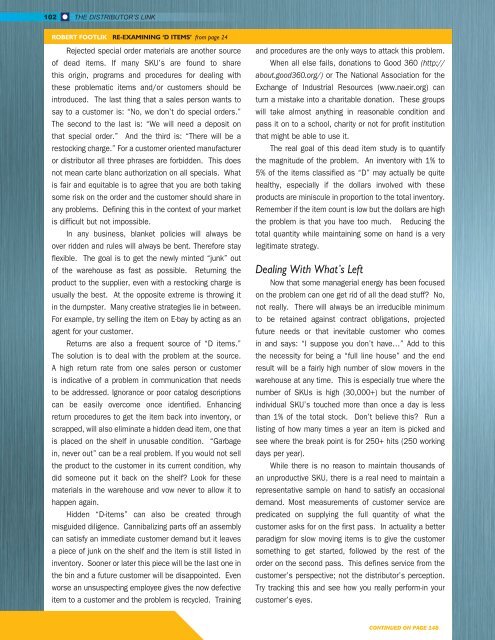WINTER 2017
Distributor's Link Magazine Winter Issue 2017 / Vol 40 No1
Distributor's Link Magazine Winter Issue 2017 / Vol 40 No1
You also want an ePaper? Increase the reach of your titles
YUMPU automatically turns print PDFs into web optimized ePapers that Google loves.
102<br />
THE DISTRIBUTOR’S LINK<br />
ROBERT FOOTLIK RE-EXAMINING ‘D ITEMS’ from page 24<br />
Rejected special order materials are another source<br />
of dead items. If many SKU’s are found to share<br />
this origin, programs and procedures for dealing with<br />
these problematic items and/or customers should be<br />
introduced. The last thing that a sales person wants to<br />
say to a customer is: “No, we don’t do special orders.”<br />
The second to the last is: “We will need a deposit on<br />
that special order.” And the third is: “There will be a<br />
restocking charge.” For a customer oriented manufacturer<br />
or distributor all three phrases are forbidden. This does<br />
not mean carte blanc authorization on all specials. What<br />
is fair and equitable is to agree that you are both taking<br />
some risk on the order and the customer should share in<br />
any problems. Defining this in the context of your market<br />
is difficult but not impossible.<br />
In any business, blanket policies will always be<br />
over ridden and rules will always be bent. Therefore stay<br />
flexible. The goal is to get the newly minted “junk” out<br />
of the warehouse as fast as possible. Returning the<br />
product to the supplier, even with a restocking charge is<br />
usually the best. At the opposite extreme is throwing it<br />
in the dumpster. Many creative strategies lie in between.<br />
For example, try selling the item on E-bay by acting as an<br />
agent for your customer.<br />
Returns are also a frequent source of “D items.”<br />
The solution is to deal with the problem at the source.<br />
A high return rate from one sales person or customer<br />
is indicative of a problem in communication that needs<br />
to be addressed. Ignorance or poor catalog descriptions<br />
can be easily overcome once identified. Enhancing<br />
return procedures to get the item back into inventory, or<br />
scrapped, will also eliminate a hidden dead item, one that<br />
is placed on the shelf in unusable condition. “Garbage<br />
in, never out” can be a real problem. If you would not sell<br />
the product to the customer in its current condition, why<br />
did someone put it back on the shelf? Look for these<br />
materials in the warehouse and vow never to allow it to<br />
happen again.<br />
Hidden “D-items” can also be created through<br />
misguided diligence. Cannibalizing parts off an assembly<br />
can satisfy an immediate customer demand but it leaves<br />
a piece of junk on the shelf and the item is still listed in<br />
inventory. Sooner or later this piece will be the last one in<br />
the bin and a future customer will be disappointed. Even<br />
worse an unsuspecting employee gives the now defective<br />
item to a customer and the problem is recycled. Training<br />
and procedures are the only ways to attack this problem.<br />
When all else fails, donations to Good 360 (http://<br />
about.good360.org/) or The National Association for the<br />
Exchange of Industrial Resources (www.naeir.org) can<br />
turn a mistake into a charitable donation. These groups<br />
will take almost anything in reasonable condition and<br />
pass it on to a school, charity or not for profit institution<br />
that might be able to use it.<br />
The real goal of this dead item study is to quantify<br />
the magnitude of the problem. An inventory with 1% to<br />
5% of the items classified as “D” may actually be quite<br />
healthy, especially if the dollars involved with these<br />
products are miniscule in proportion to the total inventory.<br />
Remember if the item count is low but the dollars are high<br />
the problem is that you have too much. Reducing the<br />
total quantity while maintaining some on hand is a very<br />
legitimate strategy.<br />
Dealing With What’s Left<br />
Now that some managerial energy has been focused<br />
on the problem can one get rid of all the dead stuff? No,<br />
not really. There will always be an irreducible minimum<br />
to be retained against contract obligations, projected<br />
future needs or that inevitable customer who comes<br />
in and says: “I suppose you don’t have…” Add to this<br />
the necessity for being a “full line house” and the end<br />
result will be a fairly high number of slow movers in the<br />
warehouse at any time. This is especially true where the<br />
number of SKUs is high (30,000+) but the number of<br />
individual SKU’s touched more than once a day is less<br />
than 1% of the total stock. Don’t believe this? Run a<br />
listing of how many times a year an item is picked and<br />
see where the break point is for 250+ hits (250 working<br />
days per year).<br />
While there is no reason to maintain thousands of<br />
an unproductive SKU, there is a real need to maintain a<br />
representative sample on hand to satisfy an occasional<br />
demand. Most measurements of customer service are<br />
predicated on supplying the full quantity of what the<br />
customer asks for on the first pass. In actuality a better<br />
paradigm for slow moving items is to give the customer<br />
something to get started, followed by the rest of the<br />
order on the second pass. This defines service from the<br />
customer’s perspective; not the distributor’s perception.<br />
Try tracking this and see how you really perform-in your<br />
customer’s eyes.<br />
CONTINUED ON PAGE 148

















